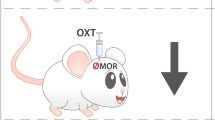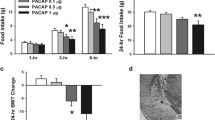Abstract
Introduction
The effects of angiotensin (Ang) IV result from binding to a constitutively active metallopeptidase known as the AT4 receptor (or oxytocinase/insulin-regulated membrane aminopeptidase). While in vitro evidence indicates that Ang IV inhibits the peptidase activity of AT4 receptors, leading to increases in the concentrations of several peptides, including oxytocin, the consequence of inhibiting AT4 peptidase activity in vivo remains unresolved.
Discussion
Microdialysis coupled to immunoassay techniques revealed that systemic and intra-amygdala injection of Nle-Ang IV, a metabolically stable derivative of Ang IV, significantly elevated extracellular levels of oxytocin in the rat amygdala. Based on earlier reports describing the anxiolytic-like effects of oxytocin, we investigated whether disrupting AT4 peptidase activity would yield similar responses. In the mouse four-plate test, acute treatment with either Nle-Ang IV or LVV-hemorphin-7, a related AT4 receptor ligand, elicited significant increases in the number of punished crossings. These behavioral responses were comparable to the anxiolytic-like effects of oxytocin and to the standard anxiolytic agent, chlordiazepoxide. Cotreatment with either the AT4 receptor antagonist, divalinal, or the selective oxytocin receptor antagonist, WAY-162720, reversed the anxiolytic-like effects of Nle-Ang IV, while combining ineffective doses of Nle-Ang IV and oxytocin increased the number of punished crossings in this assay. Conversely, Nle-Ang IV and LVV-hemorphin-7 were inactive in the mouse tail suspension test of antidepressant activity. These findings represent the first in vivo demonstration of the peptidase activity of AT4 receptors, confirm the anxiolytic-like properties of Ang IV, and reveal a unique and previously uncharacterized relationship between AT4 and oxytocin receptor systems.





Similar content being viewed by others
References
Albiston AL, Mustafa T, McDowall SG, Mendelsohn FAO, Lee J, Chai SY (2003) AT(4) receptor is insulin-regulated membrane aminopeptidase: potential mechanisms of memory enhancement. Trends Endocrinol Metab 14:72–77
Arletti R, Bertolini A (1987) Oxytocin acts as an antidepressant in two animal models of depression. Life Sci 41:1725–1730
Aron C, Simon P, Larousse C, Boissier JR (1971) Evaluation of a rapid technique for detecting minor tranquilizers. Neuropharmacology 10:459–469
Bale TL, Davis AM, Auger AP, Dorsa DM, McCarthy MM (2001) CNS region-specific oxytocin receptor expression: importance in regulation of anxiety and sex behavior. J Neurosci 21:2546–2552
Chai SY, Bastias MA, Clune EF, Matsacos DJ, Mustafa T, Lee JH, McDowall SG, Paxinos G, Mendelsohn FA, Albiston AL (2000) Distribution of angiotensin IV binding sites (AT4 receptor) in the human forebrain, midbrain and pons as visualised by in vitro receptor autoradiography. J Chem Neuroanat 20:339–348
Chai SY, Fernando R, Peck G, Ye SY, Mendelsohn FAO, Jenkins TA, Albiston AL (2004) The angiotensin IV/AT(4) receptor. Cell Mol Life Sci 61:2728–2737
Cryan JF, Mombereau C, Vassout A (2005) The tail suspension test as a model for assessing antidepressant activity: review of pharmacological and genetic studies in mice. Neurosci Biobehav Rev 29:571–625
Ferguson JN, Aldag JM, Insel TR, Young LJ (2001) Oxytocin in the medial amygdala is essential for social recognition in the mouse. J Neurosci 21:8278–8285
Gard PR, Daw P, Mashhour ZS, Tran P (2007) Interactions of angiotensin IV and oxytocin on behaviour in mice. J Renin Angiotensin Aldosterone Syst 8:133–138
Herbst JJ, Ross SA, Scott HM, Bobin SA, Morris NJ, Lienhard GE, Keller SR (1997) Insulin stimulates cell surface aminopeptidase activity toward vasopressin in adipocytes. Am J Physiol 272:E600–E606
Keller SR, Scott HM, Mastick CC, Aebersold R, Lienhard GE (1995) Cloning and characterization of a novel insulin-regulated membrane aminopeptidase from Glut4 vesicles. J Biol Chem 270:23612–23618
Kirsch P, Esslinger C, Chen Q, Mier D, Lis S, Siddhanti S, Gruppe H, Mattay VS, Gallhofer B, Meyer-Lindenberg A (2005) Oxytocin modulates neural circuitry for social cognition and fear in humans. J Neurosci 25:11489–11493
Kosfeld M, Heinrichs M, Zak PJ, Fischbacher U, Fehr E (2005) Oxytocin increases trust in humans. Nature 435:673–676
Kovacs GL, De Wied D (1994) Peptidergic modulation of learning and memory processes. Pharmacol Rev 46:269–291
Krebs LT, Kramar EA, Hanesworth JM, Sardinia MF, Ball AE, Wright JW, Harding JW (1996) Characterization of the binding properties and physiological action of divalinal-angiotensin IV, a putative AT4 receptor antagonist. Regul Pept 67:123–130
Lee J, Albiston AL, Allen AM, Mendelsohn FA, Ping SE, Barrett GL, Murphy M, Morris MJ, McDowall SG, Chai SY (2004) Effect of I.C.V. injection of AT4 receptor ligands, NLE1-angiotensin IV and LVV-hemorphin 7, on spatial learning in rats. Neuroscience 124:341–349
Lee PR, Brady DL, Shapiro RA, Dorsa DM, Koenig JI (2007) Prenatal stress generates deficits in rat social behavior: reversal by oxytocin. Brain Res 1156:152–167
Matsumoto H, Rogi T, Yamashiro K, Kodama S, Tsuruoka N, Hattori A, Takio K, Mizutani S, Tsujimoto M (2000) Characterization of a recombinant soluble form of human placental leucine aminopeptidase/oxytocinase expressed in Chinese hamster ovary cells. Eur J Biochem 267:46–52
McCarthy MM, McDonald CH, Brooks PJ, Goldman D (1996) An anxiolytic action of oxytocin is enhanced by estrogen in the mouse. Physiol Behav 60:1209–1215
Mlynarik M, Zelena D, Bagdy G, Makara GB, Jezova D (2007) Signs of attenuated depression-like behavior in vasopressin deficient Brattleboro rats. Horm Behav 51:395–405
Neumann ID, Krömer SA, Toschi N, Ebner K (2000) Brain oxytocin inhibits the (re)activity of the hypothalamo-pituitary–adrenal axis in male rats: involvement of hypothalamic and limbic brain regions. Regul Pept 96:31–38
Paxinos G, Watson C (1986) Rat brain in stereotactic coordinates. Academic, San Diego
Popik P, Vetulani J, VanRee JM (1996) Facilitation and attenuation of social recognition in rats by different oxytocin-related peptides. Eur J Pharmacol 308:113–116
Ring RH, Malberg JE, Potestio L, Ping J, Boikess S, Luo B, Schechter LE, Rizzo S, Rahman Z, Rosenzweig-Lipson S (2006) Anxiolytic-like activity of oxytocin in male mice: behavioral and autonomic evidence, therapeutic implications. Psychopharmacology (Berl) 185:218–225
Ring RH, Schechter LE, Leonard SK, Dwyer JM, Platt BJ, Graf R, Grauer S, Pulicicchio C, Resnick L, Rahman Z, Sukoff Rizzo SJ, Luo B, Beyer CE, Logue SF, Marquis KL, Hughes ZA, Rosenzweig-Lipson S (2010) Receptor and behavioral pharmacology of WAY-267464, a non-peptide oxytocin receptor agonist. Neuropharmacology 58:69–77
Ripoll N, Hascoët M, Bourin M (2006) The four-plates test: anxiolytic or analgesic paradigm? Prog Neuropsychopharmacol Biol Psychiatry 30:873–880
Rush AJ, Zimmerman M, Wisniewski SR, Fava M, Hollon SD, Warden D, Biggs MM, Shores-Wilson K, Shelton RC, Luther JF, Thomas B, Trivedi MH (2005) Comorbid psychiatric disorders in depressed outpatients: demographic and clinical features. J Affect Disord 87:43–55
Schechter LE, Lin Q, Smith DL, Zhang G, Shan Q, Platt B, Brandt MR, Dawson LA, Cole D, Bernotas R, Robichaud A, Rosenzweig-Lipson S, Beyer CE (2008) Neuropharmacological profile of novel and selective 5-HT6 receptor agonists: WAY-181187 and WAY-208466. Neuropsychopharmacology 33:1323–1335
Sofroniew MV (1983) Morphology of vasopressin and oxytocin neurons and their central vascular projections. Prog Brain Res 60:101–104
Steru L, Chermat R, Thierry B, Simon P (1985) The tail suspension test: a new method for screening antidepressants in mice. Psychopharmacology (Berl) 85:367–370
Swanson GN, Hanesworth JM, Sardinia MF, Coleman JK, Wright JW, Hall KL, Miller-Wing AV, Stobb JW, Cook VI, Harding EC et al (1992) Discovery of a distinct binding site for angiotensin II (3–8), a putative angiotensin IV receptor. Regul Pept 40:409–419
von Bohlen und Halbach O (2003) Angiotensin IV in the central nervous system. Cell Tissue Res 311:1–9
Windle RJ, Shanks N, Lightman SL, Ingram CD (1997) Central oxytocin administration reduces stress-induced corticosterone release and anxiety behavior in rats. Endocrinology 138:2829–2834
Winslow JT, Insel TR (2002) The social deficits of the oxytocin knockout mouse. Neuropeptides 36:221–229
Author information
Authors and Affiliations
Corresponding author
Rights and permissions
About this article
Cite this article
Beyer, C.E., Dwyer, J.M., Platt, B.J. et al. Angiotensin IV elevates oxytocin levels in the rat amygdala and produces anxiolytic-like activity through subsequent oxytocin receptor activation. Psychopharmacology 209, 303–311 (2010). https://doi.org/10.1007/s00213-010-1791-1
Received:
Accepted:
Published:
Issue Date:
DOI: https://doi.org/10.1007/s00213-010-1791-1




